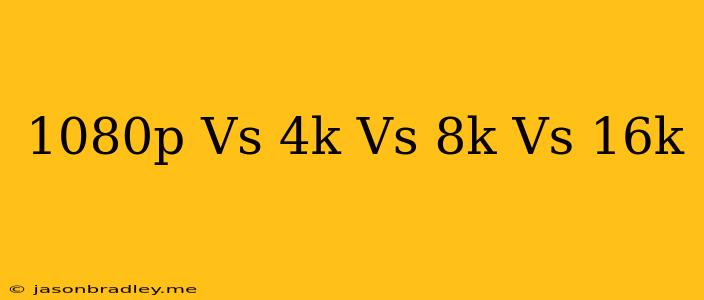1080p vs 4K vs 8K vs 16K: Which Resolution Reigns Supreme?
The world of digital displays is constantly evolving, with higher resolutions pushing the boundaries of visual fidelity. From the familiar 1080p to the mind-boggling 16K, understanding these resolutions is crucial for making informed decisions about your viewing experience. Let's delve into the differences between these formats and see which one reigns supreme.
1080p (1920 x 1080): The Standard Definition
1080p, also known as Full HD, has been the industry standard for over a decade. It offers a resolution of 1920 pixels horizontally and 1080 pixels vertically, resulting in 2.07 million pixels in total. This resolution is widely available and offers a decent viewing experience, especially for smaller screens.
Pros:
- Widely available and affordable.
- Sufficient for most content and screen sizes.
Cons:
- Pixels become visible on larger screens.
- Limited detail and sharpness compared to higher resolutions.
4K (3840 x 2160): A Significant Leap Forward
4K, also known as Ultra HD, boasts a resolution of 3840 pixels horizontally and 2160 pixels vertically, resulting in 8.29 million pixels. This is four times the resolution of 1080p, making it a significant leap in visual fidelity. 4K delivers sharper images, richer detail, and a more immersive experience, especially on larger screens.
Pros:
- Substantially sharper and more detailed images.
- Enhanced immersion for larger screens.
Cons:
- Higher cost compared to 1080p.
- Limited 4K content availability.
8K (7680 x 4320): Pushing the Boundaries
8K, also known as Super Hi-Vision, takes resolution to another level. It has 7680 pixels horizontally and 4320 pixels vertically, resulting in 33.18 million pixels. This is four times the resolution of 4K, effectively 16 times the resolution of 1080p. 8K delivers exceptional detail and clarity, making it ideal for large screens and professional applications.
Pros:
- Unparalleled detail and sharpness.
- Exceptional viewing experience on large screens.
Cons:
- Extremely high cost.
- Limited content availability.
- Requires powerful hardware for playback.
16K (15360 x 8640): The Future of Visual Fidelity
16K, or Quad Ultra High Definition, represents the cutting-edge of display technology. It boasts a resolution of 15360 pixels horizontally and 8640 pixels vertically, delivering an astounding 132.7 million pixels. This is four times the resolution of 8K and 64 times the resolution of 1080p. 16K offers an unprecedented level of detail and clarity, ideal for professional applications like film production and scientific visualization.
Pros:
- The ultimate visual fidelity.
- Extreme detail and realism.
Cons:
- Currently very expensive and limited to specialized applications.
- Limited content and hardware availability.
Choosing the Right Resolution for You
The "best" resolution for you depends entirely on your individual needs and budget. Here's a quick guide:
- 1080p: Perfect for smaller screens, budget-conscious users, and older content.
- 4K: Ideal for larger screens, modern content, and users who prioritize visual quality.
- 8K: Suitable for very large screens, professional applications, and users who crave the ultimate viewing experience.
- 16K: Currently only relevant for niche professional applications and enthusiasts.
As technology progresses, 8K and even 16K might become more accessible, but for now, 4K offers the best balance between visual quality and affordability. Regardless of your choice, ensure your chosen resolution aligns with the content you intend to consume and the size of your screen.
